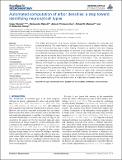| dc.contributor.author | Sumbul, Uygar | |
| dc.contributor.author | Zlateski, Aleksandar | |
| dc.contributor.author | Vishwanathan, Ashwin | |
| dc.contributor.author | Masland, Richard H. | |
| dc.contributor.author | Seung, H. Sebastian | |
| dc.date.accessioned | 2015-01-07T21:47:59Z | |
| dc.date.available | 2015-01-07T21:47:59Z | |
| dc.date.issued | 2014-11 | |
| dc.date.submitted | 2014-07 | |
| dc.identifier.issn | 1662-5129 | |
| dc.identifier.uri | http://hdl.handle.net/1721.1/92750 | |
| dc.description.abstract | The shape and position of a neuron convey information regarding its molecular and functional identity. The identification of cell types from structure, a classic method, relies on the time-consuming step of arbor tracing. However, as genetic tools and imaging methods make data-driven approaches to neuronal circuit analysis feasible, the need for automated processing increases. Here, we first establish that mouse retinal ganglion cell types can be as precise about distributing their arbor volumes across the inner plexiform layer as they are about distributing the skeletons of the arbors. Then, we describe an automated approach to computing the spatial distribution of the dendritic arbors, or arbor density, with respect to a global depth coordinate based on this observation. Our method involves three-dimensional reconstruction of neuronal arbors by a supervised machine learning algorithm, post-processing of the enhanced stacks to remove somata and isolate the neuron of interest, and registration of neurons to each other using automatically detected arbors of the starburst amacrine interneurons as fiducial markers. In principle, this method could be generalizable to other structures of the CNS, provided that they allow sparse labeling of the cells and contain a reliable axis of spatial reference. | en_US |
| dc.description.sponsorship | United States. Army Research Office (W911NF-12-1-0594) | en_US |
| dc.description.sponsorship | United States. Defense Advanced Research Projects Agency (DARPA (HR0011-14-2-0004)) | en_US |
| dc.description.sponsorship | National Institutes of Health (U.S.) (NIH/NINDS) | en_US |
| dc.description.sponsorship | Howard Hughes Medical Institute | en_US |
| dc.description.sponsorship | Gatsby Charitable Foundation | en_US |
| dc.description.sponsorship | Human Frontier Science Program (Strasbourg, France) | en_US |
| dc.language.iso | en_US | |
| dc.publisher | Frontiers Research Foundation | en_US |
| dc.relation.isversionof | http://dx.doi.org/10.3389/fnana.2014.00139 | en_US |
| dc.rights | Creative Commons Attribution | en_US |
| dc.rights.uri | http://creativecommons.org/licenses/by/4.0/ | en_US |
| dc.source | Frontiers Research Foundation | en_US |
| dc.title | Automated computation of arbor densities: a step toward identifying neuronal cell types | en_US |
| dc.type | Article | en_US |
| dc.identifier.citation | Sümbül, Uygar, Aleksandar Zlateski, Ashwin Vishwanathan, Richard H. Masland, and H. Sebastian Seung. “Automated Computation of Arbor Densities: a Step Toward Identifying Neuronal Cell Types.” Front. Neuroanat. 8 (November 25, 2014). | en_US |
| dc.contributor.department | Massachusetts Institute of Technology. Department of Brain and Cognitive Sciences | en_US |
| dc.contributor.department | Massachusetts Institute of Technology. Department of Electrical Engineering and Computer Science | en_US |
| dc.contributor.mitauthor | Sumbul, Uygar | en_US |
| dc.contributor.mitauthor | Zlateski, Aleksandar | en_US |
| dc.contributor.mitauthor | Vishwanathan, Ashwin | en_US |
| dc.relation.journal | Frontiers in Neuroanatomy | en_US |
| dc.eprint.version | Final published version | en_US |
| dc.type.uri | http://purl.org/eprint/type/JournalArticle | en_US |
| eprint.status | http://purl.org/eprint/status/PeerReviewed | en_US |
| dspace.orderedauthors | Sümbül, Uygar; Zlateski, Aleksandar; Vishwanathan, Ashwin; Masland, Richard H.; Seung, H. Sebastian | en_US |
| dc.identifier.orcid | https://orcid.org/0000-0001-5901-7964 | |
| mit.license | PUBLISHER_CC | en_US |
| mit.metadata.status | Complete | |
